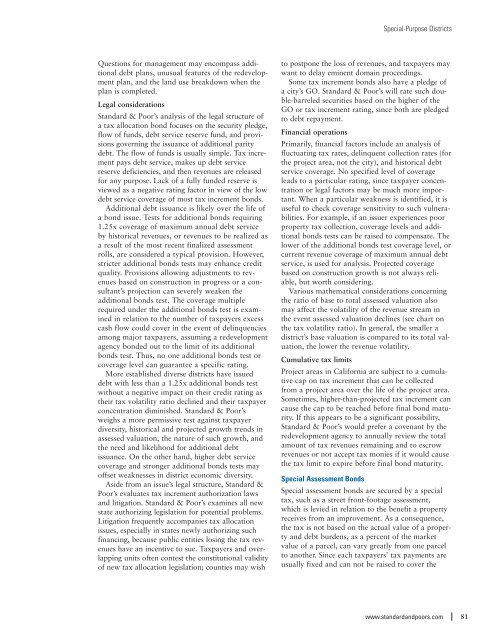S&P - Public Finance Criteria (2007). - The Global Clearinghouse
S&P - Public Finance Criteria (2007). - The Global Clearinghouse
S&P - Public Finance Criteria (2007). - The Global Clearinghouse
Create successful ePaper yourself
Turn your PDF publications into a flip-book with our unique Google optimized e-Paper software.
Special-Purpose DistrictsQuestions for management may encompass additionaldebt plans, unusual features of the redevelopmentplan, and the land use breakdown when theplan is completed.Legal considerationsStandard & Poor’s analysis of the legal structure ofa tax allocation bond focuses on the security pledge,flow of funds, debt service reserve fund, and provisionsgoverning the issuance of additional paritydebt. <strong>The</strong> flow of funds is usually simple. Tax incrementpays debt service, makes up debt servicereserve deficiencies, and then revenues are releasedfor any purpose. Lack of a fully funded reserve isviewed as a negative rating factor in view of the lowdebt service coverage of most tax increment bonds.Additional debt issuance is likely over the life ofa bond issue. Tests for additional bonds requiring1.25x coverage of maximum annual debt serviceby historical revenues, or revenues to be realized asa result of the most recent finalized assessmentrolls, are considered a typical provision. However,stricter additional bonds tests may enhance creditquality. Provisions allowing adjustments to revenuesbased on construction in progress or a consultant’sprojection can severely weaken theadditional bonds test. <strong>The</strong> coverage multiplerequired under the additional bonds test is examinedin relation to the number of taxpayers excesscash flow could cover in the event of delinquenciesamong major taxpayers, assuming a redevelopmentagency bonded out to the limit of its additionalbonds test. Thus, no one additional bonds test orcoverage level can guarantee a specific rating.More established diverse districts have issueddebt with less than a 1.25x additional bonds testwithout a negative impact on their credit rating astheir tax volatility ratio declined and their taxpayerconcentration diminished. Standard & Poor’sweighs a more permissive test against taxpayerdiversity, historical and projected growth trends inassessed valuation, the nature of such growth, andthe need and likelihood for additional debtissuance. On the other hand, higher debt servicecoverage and stronger additional bonds tests mayoffset weaknesses in district economic diversity.Aside from an issue’s legal structure, Standard &Poor’s evaluates tax increment authorization lawsand litigation. Standard & Poor’s examines all newstate authorizing legislation for potential problems.Litigation frequently accompanies tax allocationissues, especially in states newly authorizing suchfinancing, because public entities losing the tax revenueshave an incentive to sue. Taxpayers and overlappingunits often contest the constitutional validityof new tax allocation legislation; counties may wishto postpone the loss of revenues, and taxpayers maywant to delay eminent domain proceedings.Some tax increment bonds also have a pledge ofa city’s GO. Standard & Poor’s will rate such double-barreledsecurities based on the higher of theGO or tax increment rating, since both are pledgedto debt repayment.Financial operationsPrimarily, financial factors include an analysis offluctuating tax rates, delinquent collection rates (forthe project area, not the city), and historical debtservice coverage. No specified level of coverageleads to a particular rating, since taxpayer concentrationor legal factors may be much more important.When a particular weakness is identified, it isuseful to check coverage sensitivity to such vulnerabilities.For example, if an issuer experiences poorproperty tax collection, coverage levels and additionalbonds tests can be raised to compensate. <strong>The</strong>lower of the additional bonds test coverage level, orcurrent revenue coverage of maximum annual debtservice, is used for analysis. Projected coveragebased on construction growth is not always reliable,but worth considering.Various mathematical considerations concerningthe ratio of base to total assessed valuation alsomay affect the volatility of the revenue stream inthe event assessed valuation declines (see chart onthe tax volatility ratio). In general, the smaller adistrict’s base valuation is compared to its total valuation,the lower the revenue volatility.Cumulative tax limitsProject areas in California are subject to a cumulativecap on tax increment that can be collectedfrom a project area over the life of the project area.Sometimes, higher-than-projected tax increment cancause the cap to be reached before final bond maturity.If this appears to be a significant possibility,Standard & Poor’s would prefer a covenant by theredevelopment agency to annually review the totalamount of tax revenues remaining and to escrowrevenues or not accept tax monies if it would causethe tax limit to expire before final bond maturity.Special Assessment BondsSpecial assessment bonds are secured by a specialtax, such as a street front-footage assessment,which is levied in relation to the benefit a propertyreceives from an improvement. As a consequence,the tax is not based on the actual value of a propertyand debt burdens, as a percent of the marketvalue of a parcel, can vary greatly from one parcelto another. Since each taxpayers’ tax payments areusually fixed and can not be raised to cover thewww.standardandpoors.com81
















